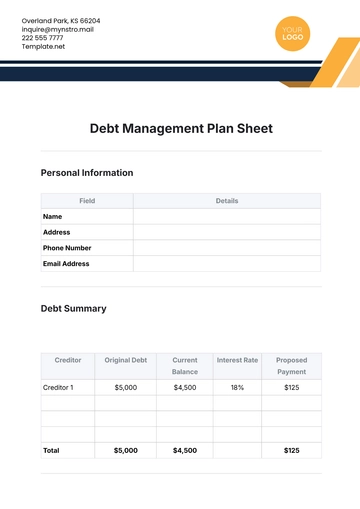Free Long-Term Stock Trading Plan

I. Introduction
This Long-Term Stock Trading Plan is designed to secure financial stability in retirement for [YOUR NAME]. The plan outlines the investment goals, strategies, risk management techniques, and performance evaluation criteria to ensure a disciplined and consistent approach to stock trading over the long term.
Company Information
Company: [YOUR COMPANY NAME]
Address: [YOUR COMPANY ADDRESS]
Website: [YOUR COMPANY WEBSITE]
Social Media: [YOUR COMPANY SOCIAL MEDIA]
II. Investment Goals
The primary goal of this plan is to build a retirement portfolio that provides financial security and stability. Specific objectives include:
Accumulating sufficient funds to cover living expenses during retirement.
Generating a steady income stream through dividends and interest.
Ensuring the portfolio grows at a rate that outpaces inflation.
III. Market Analysis
An in-depth analysis of current market conditions and trends will guide stock selection and investment strategies. Key considerations include:
Economic indicators (GDP growth, unemployment rates, inflation).
Market sentiment and investor behavior.
Sector performance and potential growth industries.
IV. Stock Selection Criteria
Stocks will be selected based on the following criteria to ensure they align with long-term investment goals:
Fundamental Analysis: Evaluating financial statements, earnings growth, and company health.
Valuation Metrics: Price-to-earnings ratio (P/E), price-to-book ratio (P/B), dividend yield.
Growth Potential: Companies with strong growth prospects and competitive advantages.
Dividend History: Preference for companies with a consistent and growing dividend payout.
V. Risk Management Strategies
Effective risk management is crucial to preserving capital and ensuring long-term financial stability. Strategies include:
Diversification: Spreading investments across various sectors and asset classes to reduce risk.
Asset Allocation: Allocating a percentage of the portfolio to stocks, bonds, and other assets based on risk tolerance and investment horizon.
Regular Review: Periodically reviewing and rebalancing the portfolio to maintain the desired risk level.
Stop-Loss Orders: Setting stop-loss orders to limit potential losses on individual stocks.
VI. Portfolio Allocation
A balanced approach to portfolio allocation will be employed to achieve growth and income objectives. The initial allocation will be as follows:
Asset Class | Allocation Percentage |
|---|---|
Growth Stocks | 40% |
Dividend-Paying Stocks | 30% |
Bonds and Fixed Income | 20% |
Cash and Equivalents | 10% |
VII. Performance Review and Adjustments
Regular performance reviews will be conducted to ensure the portfolio remains aligned with investment goals. Key activities include:
Quarterly Reviews: Assessing the performance of individual stocks and the overall portfolio.
Annual Adjustments: Rebalancing the portfolio to maintain the target allocation and risk profile.
Benchmarking: Comparing portfolio performance against relevant benchmarks (like S&P 500).
Performance Review Schedule
Review Period | Activities |
|---|---|
Quarterly | Performance assessment, stock evaluation |
Annually | Portfolio rebalancing, goal reassessment |
VIII. Conclusion
This Long-Term Stock Trading Plan provides a comprehensive framework for achieving financial stability in retirement. By adhering to the outlined strategies and regularly reviewing performance, [YOUR NAME] can build a robust and resilient retirement portfolio.
- 100% Customizable, free editor
- Access 1 Million+ Templates, photo’s & graphics
- Download or share as a template
- Click and replace photos, graphics, text, backgrounds
- Resize, crop, AI write & more
- Access advanced editor
Invest in your future with the Long-Term Stock Trading Plan Template that’s exclusively available at Template.net. Customizable and editable in our AI Editor Tool, this template provides a structured approach to long-term stock investments. Ensure consistent growth and strategic planning with this essential investment tool. Make this template yours now!
You may also like
- Finance Plan
- Construction Plan
- Sales Plan
- Development Plan
- Career Plan
- Budget Plan
- HR Plan
- Education Plan
- Transition Plan
- Work Plan
- Training Plan
- Communication Plan
- Operation Plan
- Health And Safety Plan
- Strategy Plan
- Professional Development Plan
- Advertising Plan
- Risk Management Plan
- Restaurant Plan
- School Plan
- Nursing Home Patient Care Plan
- Nursing Care Plan
- Plan Event
- Startup Plan
- Social Media Plan
- Staffing Plan
- Annual Plan
- Content Plan
- Payment Plan
- Implementation Plan
- Hotel Plan
- Workout Plan
- Accounting Plan
- Campaign Plan
- Essay Plan
- 30 60 90 Day Plan
- Research Plan
- Recruitment Plan
- 90 Day Plan
- Quarterly Plan
- Emergency Plan
- 5 Year Plan
- Gym Plan
- Personal Plan
- IT and Software Plan
- Treatment Plan
- Real Estate Plan
- Law Firm Plan
- Healthcare Plan
- Improvement Plan
- Media Plan
- 5 Year Business Plan
- Learning Plan
- Marketing Campaign Plan
- Travel Agency Plan
- Cleaning Services Plan
- Interior Design Plan
- Performance Plan
- PR Plan
- Birth Plan
- Life Plan
- SEO Plan
- Disaster Recovery Plan
- Continuity Plan
- Launch Plan
- Legal Plan
- Behavior Plan
- Performance Improvement Plan
- Salon Plan
- Security Plan
- Security Management Plan
- Employee Development Plan
- Quality Plan
- Service Improvement Plan
- Growth Plan
- Incident Response Plan
- Basketball Plan
- Emergency Action Plan
- Product Launch Plan
- Spa Plan
- Employee Training Plan
- Data Analysis Plan
- Employee Action Plan
- Territory Plan
- Audit Plan
- Classroom Plan
- Activity Plan
- Parenting Plan
- Care Plan
- Project Execution Plan
- Exercise Plan
- Internship Plan
- Software Development Plan
- Continuous Improvement Plan
- Leave Plan
- 90 Day Sales Plan
- Advertising Agency Plan
- Employee Transition Plan
- Smart Action Plan
- Workplace Safety Plan
- Behavior Change Plan
- Contingency Plan
- Continuity of Operations Plan
- Health Plan
- Quality Control Plan
- Self Plan
- Sports Development Plan
- Change Management Plan
- Ecommerce Plan
- Personal Financial Plan
- Process Improvement Plan
- 30-60-90 Day Sales Plan
- Crisis Management Plan
- Engagement Plan
- Execution Plan
- Pandemic Plan
- Quality Assurance Plan
- Service Continuity Plan
- Agile Project Plan
- Fundraising Plan
- Job Transition Plan
- Asset Maintenance Plan
- Maintenance Plan
- Software Test Plan
- Staff Training and Development Plan
- 3 Year Plan
- Brand Activation Plan
- Release Plan
- Resource Plan
- Risk Mitigation Plan
- Teacher Plan
- 30 60 90 Day Plan for New Manager
- Food Safety Plan
- Food Truck Plan
- Hiring Plan
- Quality Management Plan
- Wellness Plan
- Behavior Intervention Plan
- Bonus Plan
- Investment Plan
- Maternity Leave Plan
- Pandemic Response Plan
- Succession Planning
- Coaching Plan
- Configuration Management Plan
- Remote Work Plan
- Self Care Plan
- Teaching Plan
- 100-Day Plan
- HACCP Plan
- Student Plan
- Sustainability Plan
- 30 60 90 Day Plan for Interview
- Access Plan
- Site Specific Safety Plan





























